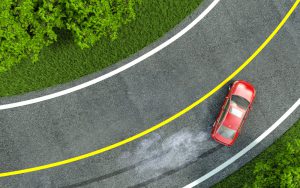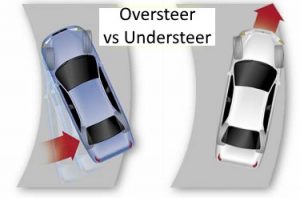

Posted: November 11, 2016

If you want to become a great track day or race driver, one of the core skills you’ll need to learn is how to drive on and over grip limit. Drive on any circuit here in the UK in November and the changeable tarmac conditions will give you every opportunity to put your skills to the test. But what happens if you push your car beyond the grip limit and get out of shape? Are you comfortable correcting understeer or oversteer? Here at CAT we use Caterham 7s to teach drifting and over grip handling skills and we’ve put together some of the most common questions we get asked on the course and answered them below.
What is Understeer?
If my vehicle is understeering, the front of the vehicle is travelling quicker than the rear. It is steering less than I need to negotiate the turn. Imagine driving on a large circle at grip limit as I increase power - the front of the vehicle will leave the circle.
Why does my car inherently understeer through a corner on circuit?
It’s all about safety. Manufacturers, irrespective of the configuration and drive train layout of the vehicle, tune understeer into a vehicle’s platform as it is safer. It is less complex to correct than oversteer. Its correction is instinctive – simply ease off the gas pedal and the understeer will reduce. Oversteer correction on the other hand, is a complex process requiring timely and accurate counter steering input from the driver. When faced with a dangerous driving scenario, oversteer correction is not as instinctive as simply reducing your foot pressure on the gas pedal to reduce understeer.
What is Oversteer?
If my vehicle is oversteering, the rear of the vehicle is travelling quicker than the front. It is steering more than I need to negotiate the turn. Driving the same circle at grip limit as I increase power, the rear of the vehicle will leave the circle.
When my car oversteers in a corner I don’t seem to be able to stop it spinning
Inexperienced drivers have a tendency to react much too slowly and too conservatively on the steering wheel when attempting to control an oversteering vehicle. Counter steer input has to equal oversteer angle in order to correct the slide. In essence, if the back of the car steps out by 30 degrees, it will take a 30 degree counter steer (turn into the slide) at the steering wheel to correct the slide and see you heading off in the intended direction. Problems can occur if the driver has not sensed the speed of the oversteer (Yaw rate). Your counter steer needs to be at the same rate as the yaw rate. Let the car get too out of shape and ahead of your counter steer and the car will spin. Work your hands at a speed that is ahead of the yaw rate and you will find it easier to correct the slide.
Why do I see drivers on motoring shows momentarily letting go of the steering wheel when their car over steers?
It is simply to allow the steering angle to equal the yaw rate of the vehicle. If the vehicle oversteers aggressively it may not be possible to counter steer quickly enough to stop the slide. Momentarily releasing your grip on the wheel allows the yaw rate and steering input to equalise. Only try this under supervision with an instructor, and in a safe environment. It takes practice to perfect.
What should I do with the accelerator when my car is oversteering?
Today’s complex in-built stability systems can help to correct a sliding vehicle and, depending on the system, can proportion drive away from the over speeding wheels to aid correction and corner exit speed. What they can’t do is defy physics. They can only help manage the available grip between the tyre and the road. The safest advice is to smoothly and precisely reduce the amount of power to the over speeding wheels gently. Getting out of the gas will aid recovery. It is important not to snap the throttle shut as the vehicle needs some forward driven motion to aid recovery. If you are driving a front wheel drive configuration then the opposite applies. Increasing power helps to pull the front of the vehicle straight.
My car handles differently when driven through left and right hand corners. Is it me or the car?
We see this regularly on the Steering Pad at Millbrook, one of the circuits where we explore understeer and oversteer here at CAT. One of our own training cars - a Subaru STi - last year left a puddle of oil on the garage floor around the near side rear wheel. The rear damper seals had let go. A rebuild of all four dampers has breathed new life back into our trusty work horse.
Track days accelerate the wear rates of many components, so it pays to be vigilant with your maintenance. Running heavily over kerbs and rumble strips is enough to change geometry settings and damage wheel rims. Periodic alignment checks will help to keep your vehicle pointing in the right direction through corners. If you have adjustable dampers fitted, make sure the settings are as intended. Handling irregularities can simply be incorrect settings side to side. This regularly seems to be the case when clients have recently purchased their vehicle and not checked the settings.
Where should I be looking if my car oversteers through a corner?
In a previous blog post, we touched on the importance of where to look when you get into a tricky situation when driving. If you are out of shape through a corner don’t forget to keep looking where you want the car to go. Over grip limit driving, as with all driving activities, is based on looking in the correct place. You may be surprised at the drift angles you can recover from if you keep looking at the tarmac and not the scene of the accident.
That’s all in this week’s article. If you’ve enjoyed this short piece and would like to find out more about drifting and over grip limit handling, you can visit this page on our website or better still - drop us a call on 01234 757 633.
Thanks for reading.
Call: 01234 757 633
Email: info@catdrivertraining.co.uk
CAT Driver Training is the fast way to develop & improve authentic dynamic driving skill, technique & knowledge from the Best. OEM recognised driver training for individuals & the motor industry. As the leading UK based independent advanced performance driving skills company, we exist to make your driving experience even better. Explore your cars potential, fulfill your own. Coaching advanced road & track skills, safety driver training courses for individual driving enthusiasts & advanced driving for all facets of the motor industry. The only training company resident within UTAC's Millbrook Proving Ground in Bedfordshire, within easy reach of London, & all surrounding counties: Hertfordshire; Buckinghamshire; Oxfordshire; Nottinghamshire; Cambridgeshire; Norfolk; Suffolk; Essex; & Surrey. Clients travel from the World over & the UK to learn from the authentic evidence based dynamic driving & vehicle dynamic experts. | All Rights Reserved | Copyright 2005 – 2025
Some of the links we use are affiliate links. This means that, at no cost to you, CAT will earn an affiliate commission if you click through the link and finalise a purchase.
Designed by WHP
Coded and built by Prominent Media